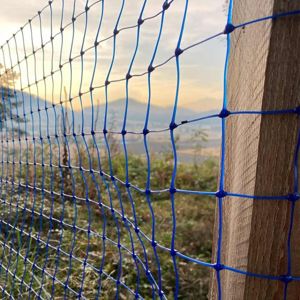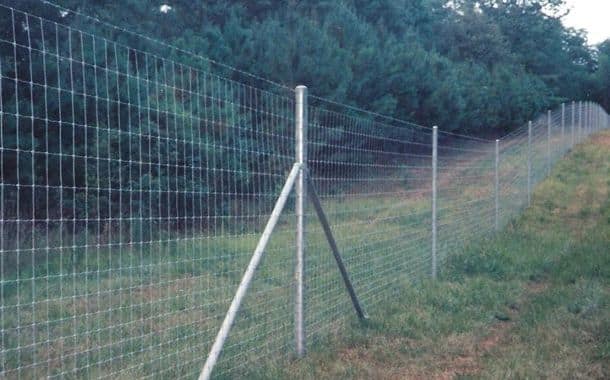How Much Does Game Fencing Cost?
Last Updated on April 15, 2024
Written by CPA Alec Pow | Content Reviewed by ![]() CFA Alexander Popinker
CFA Alexander Popinker
Installing specialized game fencing allows landowners, farmers, and reserves to safely contain wildlife, protect property, and enable conservation efforts. But what exactly impacts the costs of quality game fencing?
Material and installation prices typically range from $2 to $30+ per linear foot depending on the animal species involved, fence height and strength required, total perimeter length, and terrain challenges.
This comprehensive guide examines common game fencing types, key pricing factors, installation and maintenance considerations, tips for cost control, and advice for selecting experienced professional fencing contractors to bring your unique project vision to life.
Properly estimating expenditures helps ensure you can implement an effective wildlife containment solution for your needs and budget.
How Much Does Game Fencing Cost?
Basic agricultural-grade fencing made from 12 gauge high tensile wire and wooden posts often ranges from $2 to $6 per linear foot including basic installation.
Heavy-duty woven game fencing reinforced for containing large strong animals like bears, bison, or elk typically ranges from $10 to $30+ per linear foot for materials and professional installation tailored to the species and terrain.
Other costs like solar chargers, insulators, excavation, and gates can add another 20-30% on top of the base fencing materials price. Overall spending depends heavily on the length and site complexity involved.
AquaGart provides a complete set of game fencing, including posts, tension wire, and wire tensioners. The cost of a 200-meter game fencing set is €1,500.00.
First Class Fencing offers game fencing for Alberta, Canada, and provides affordable financing options for fencing projects starting at $44.91/month.
A YouTube video explains the cost of high game fencing, mentioning that the cost per mile ranges from $50,000 to $55,000. The video also highlights that a high game fence typically costs 27% more than a typical low fence.
Overview of Game Fencing Materials
Several game fencing options are commonly used, each with advantages and disadvantages:
- High tensile wire – Galvanized steel wire fencing installed in a tensioned crisscross or diamond pattern, often 8-12 feet tall. More cost-effective but requires regular maintenance and repairs.
- Woven wire – Interwoven horizontal and vertical galvanized steel wire strands creating smaller 1” x 4” mesh patterns. Excellent for smaller animals but more expensive.
- Electric fencing – Electrified wire or mesh fencing with an integrated low-impedance charger. More affordable but requires very diligent maintenance and power source.
- Chain link – Heavy-duty galvanized steel wire woven into 2” diamond mesh patterns. The most secure and escape-proof but also higher priced.
Evaluate which fencing type makes the most sense for the specific wildlife species based on their size, strength, climbing abilities, and temperaments. Also factor long-term maintenance requirements into material selection.
Factors Influencing Game Fencing Costs
Several important considerations affect overall budgets:
- Animal species – The fencing height, mesh size, and strength must contain animals securely. Bigger, stronger, or more aggressive wildlife requires more heavy-duty materials and construction, elevating costs.
- Enclosure size – More perimeter fencing linear footage requires greater material quantities, driving spending higher. Budget extra materials for undulating topography.
- Terrain challenges – Irregular hillsides, wetlands, or dense vegetation make for specialized installation methods and added labor expenses.
- Site accessibility – Remote locations or dense forests require clearing equipment rentals and costs to transport fencing materials and workers.
- Material grades – Premium UV and corrosion resistant steel alloys and tighter mesh patterns add cost but also extend fencing lifespan considerably.
- Gates – Heavy-duty motorized gates cost much more than standard manual gates but allow equipment passage for maintenance.
- Permits – Environmental impact studies or permits may apply for large-scale fencing projects crossing wetlands or wildlife travel corridors. Plan accordingly.
Game Fencing Installation Cost Comparison
DIY installation can potentially save 50% on labor if the landowner has the proper equipment, skills, time, and precision required for quality installations. But significant risks exist for containment failures or animal injuries with subpar DIY fence work.
Professional installation ensures experienced build standards, proper anchoring, and customized wildlife-proofing to prevent escapes or harm. Contractors typically charge around $10 to $15 per linear foot including equipment and materials. Economies of scale can lower per-foot costs for very large projects.
Evaluate if the DIY savings outweigh the liability risks of improper installations failing to safely contain animals long-term when making the build approach decision. Expertise is valuable.
Additional Game Fencing Project Expenses
You might also like our articles on the cost of invisible pet fences, vinyl fences, or aluminum fences.
Beyond the main materials and installation costs, it’s important to budget for:
- Site preparation – Surveying, access clearing, brush removal, grading, leveling, access road establishment. This facilitates quality installations.
- Equipment rental – Loaders, augers, post pounders, jackhammers, tensioners, backhoes. Required tools for proper full-scale installations.
- Regular maintenance – $200+ annually per mile for proactive inspections, vegetation trimming, damage repairs to maintain integrity.
- Solar chargers & electrical – $200-$500 per charger for electric systems. Wiring, backup battery costs are extra.
- Permits & studies – Potential environmental impact assessments, Corps permits if occupying wetlands during installation. Area dependent.
Anticipating these additional expenses helps avoid budget surprises down the line after installations are underway.
Controlling Game Fencing Costs
Savvy ways to reduce game fencing project expenditures include:
- Select galvanized steel materials rather than costlier stainless steel grades unless the local environment is highly corrosive. Seek warranty protections.
- Specify high-tensile smooth wire fencing instead of more rigid mesh options where appropriate for the animals being contained.
- Focus initial fencing investments on perimeter zones essential for core containment if phasing in installation over time.
- Utilize natural barriers like coastlines, rivers, steep ravines or cliffs to minimize fence length requirements.
- Precisely survey boundaries and seek supplier bulk discounts well in advance. Last minute change orders or short material supplies waste money.
- Provide your own access clearing and grading prep work with existing equipment if possible.
- Research forming a purchasing cooperative with neighboring landowners to get steep bulk pricing on jointly funded fencing projects.
How to Choose a Reliable Fencing Contractor
 Reputable fencing contractors demonstrate:
Reputable fencing contractors demonstrate:
- Years of verifiable experience flawlessly installing game fencing for similar wildlife species as your project. Request regional references.
- An extensive gallery of finished game fencing installations showcasing their quality craftsmanship and containment results.
- Knowledge of regional permitting processes, environmental regulations, and wildlife agency guidelines to ensure legal compliance.
- Comprehensive multi-year warranty coverage for both labor and materials, signaling confidence in their workmanship.
- Crew training and individual personnel certification on proper wildlife containment principles and animal psychology, ensuring humane practices.
- Sophisticated equipment like tensionometers, powered post drivers, and laser-leveled gate hangs for precision installs.
Don’t simply choose the lowest bidder – the risks are too high. Invest in specialists.
Final Words
Planning and investing in quality game fencing tailored to your wildlife species provides safe, effective containment and enables conservation efforts. While materials and professional installation carry costs ranging from $2 to $30+ per linear foot, proper fencing prevents escapes, protects animals and property, and lasts decades when properly maintained. Do your homework selecting knowledgeable partners to make your unique vision a reality within budget constraints.
Frequently Asked Questions
What is cheaper than fencing?
Some lower-cost animal containment alternatives include:
Plant hedges or shrubs – Prickly, dense vegetation like hawthorn or blackberry bushes can deter animal movement. Lower upfront cost than fencing but requires continual maintenance. Only works for smaller animals.
Rock wall barriers – Labor intensive but using local stone or boulders for short sections may be cheaper than full game fencing. Doesn’t contain climbing animals well.
Noise/ultrasonic deterrents – Devices emitting frequencies to startle animals away from boundaries. Effective for deer but reliability varies. Purchase cost of $30-$75 but fencing still needed for full containment.
Natural penning – Utilize and enhance natural barriers like existing ravines, lakes, or steep hillsides to minimize fencing needed for containment zones. Site dependent.
For full, reliable containment, quality fencing tailored to the animals remains the most effective solution long-term. But supplemental options can help reduce total length and costs.
What type of fencing is most expensive?
Wrought iron and ornamental metal fencing tend to be the most expensive residential fence styles, with costs ranging from $25 to $85 per linear foot installed. The primary reasons are:
- Intricate scrollwork and decorations require specialized skill and substantial labor time to manufacture and install compared to basic chain link or vinyl fencing. The craftsmanship contributes significantly to costs.
- Wrought iron is solid and heavy, weighing 2-3 times more per foot than other fencing, resulting in expenses for specialized equipment to transport and install it.
- The raw materials of iron and steel are inherently more expensive than PVC or aluminum alternatives used in lower-cost fences.
- Coatings like powder coating or galvanization to protect the metal and avoid rusting also add price compared to other fence types.
For game fencing, these ornamental styles offer little benefit beyond aesthetics over cost-effective high tensile wire or steel mesh. But for high-end residential properties desiring sophisticated accents, they provide unique visual appeal.
Is metal fencing cheaper?
On average, basic metal wire or chain link fencing costs less than wood privacy fencing, running $8 to $20 per foot versus $15 to $30 for wood. A few reasons metal fencing can be cheaper:
- Metal wiring is more economical than high-quality wood boards or planks for fencing. Even pressure-treated pine is often more expensive than galvanized wire.
- Chain link and wire involves simpler quick installation compared to constructing full wood frame panels, lowering labor.
- Metal fencing doesn’t require the frequent staining, sealing and repairs that wood fencing does over time to maintain appearance and prevent rot.
However, metal lacks the rich appearance and privacy of wood fencing that many homeowners prefer despite the higher cost. For strictly utilitarian purposes like animal control, metal wire or chain link provides affordable containment. But evaluate aesthetics, maintenance and longevity tradeoffs for your specific property uses. The cheapest option isn’t always the best long-term choice.


Leave a Reply
Want to join the discussion?Feel free to contribute!